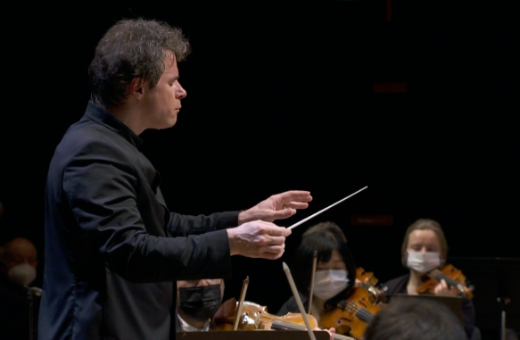After almost simultaneous cancellations by the Berlin Staatskapelle and the Filarmonica della Scala, orchestra lovers at the Philharmonie de Paris could be forgiven a level of anxiety about their Sunday 16th January. Thank goodness, the Bamberg Symphony passed unscathed through the droplets of Omicron to enter, one at a time, into the Pierre Boulez Great Hall. The relief! It's even more of a miracle given that the Bavarian orchestra showed up at full size: the usual boundaries of the performing space had to be extended and the stage lowered to the same level as the front seats of the stalls to hold the full complement of musicians. Prudently, the strings were laid out at one player per desk.
Arriving on the podium, the orchestra's Chief Conductor, Jakub Hrůša, took a spell of silence to marshal his troops before launching into the opening Andante comodo. Mahler's Symphony no. 9 has the strange feature of opening and closing with slow movements of incomparable breadth, a double farewell to the world and to love in a direct relation to Das Lied von der Erde. Between these two imposing pillars, the Ländler second movement and the Rondo burlesque third show us a condensed digest of the Mahlerian universe, from the popular heritage of Austria to the “furious craftsmanship” announcing the musical 20th century.
From the first movement, the music is a model of clarity: everything will be permitted, the erudite and the popular, fury and mystery. The orchestra shows as much mastery of the long and winding melodic lines as the vivid and savage counterpoint which, in the hands of a less accomplished orchestra, would descend into chaos. The Bamberg Symphony show a clear sense of polyphony without Hrůša needing to set himself up as the medium of communication between instruments. The string sound seems to ascend from the depths of each desk – the characteristic sign of the best Germanic orchestras – giving the impression of an irresistible tide. But above all, every attack, articulation and length of note is naturally consistent, whether it's the heavy feet of the Ländler (what a performance from the second violins!) or the delicate motifs of the outer movements. For these musicians, Mahler is clearly their mother tongue.
Behind the strings, the woodwind and brass players know exactly when to colour this texture and when they should lift themselves out of it. Tuba, bassoons and double basses form a platform of unshakeable solidity; flute, piccolo, oboes and horns play chameleon in the succession of timbres with the ear of accomplished chamber musicians; trumpet, tympani, cymbals and harps shine one after the other with interjections calibrated to the millimetre, like the cogs of a perfectly oiled musical machine.

All this structural perfection could be rather cold or ineloquent were it not for the fact that at every turn, Hrůša finds exactly the right tone. With an arm that can do anything, to carve out a rapid measure or to hold an impossibly slow beat, the maestro knows how to reassure his forces with a clear indication; just as much, he can inspire them merely by his concentrated posture. He trusts his musicians to get the correct details of balance (which have, no doubt, been the subject of punishing efforts in rehearsal). Rather, the principal tasks that Hrůša sets himself are to show the broad dynamic contour and to take care of tempi. That's what allows the thread of musical meaning to remain unbroken in spite of the breadth of its form, while the conductor plays the Mahlerian game to its extremes: the oboe is pushed to its limits on the final interminable held notes of the first movement; the Ländler is as grotesque as you could wish for, the Rondo burlesque brushes against the speed limits and the last movement finishes almost on a single horsehair of the bow, in the exhausted winding down of a sonic world whose flickering flame is about to become extinguished. Holding their breath under face masks, ears open wide, the audience will spend a long time exploring the silent ashes of this legendary Ninth. It's fortunate indeed that the cameras of Philharmonie Live have captured it for posterity: I can't recommend more strongly that you dive in.
Translated from French by David Karlin


